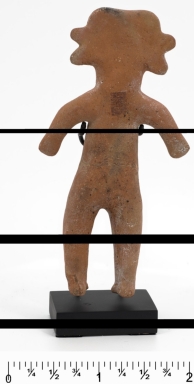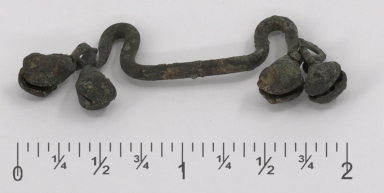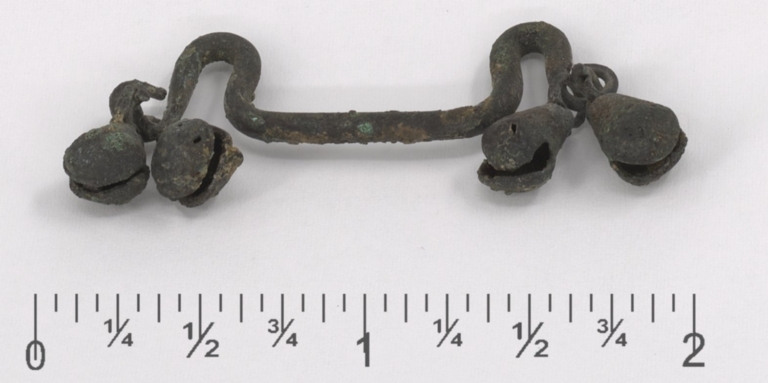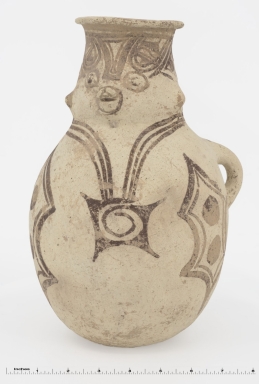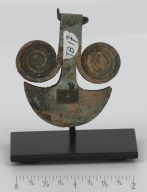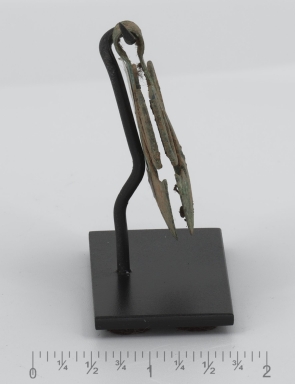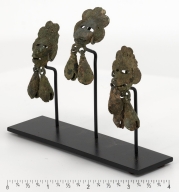Who What Where WhenREMOVEWHAT
WHO
|
Title
Mixtec Pedestal Bowl: Mixcoatl Motif
Description
The Eastern Nahua participated in elaborate gatherings that brought various groups together to cement social and political relationships. Entertainment required story telling, gift giving, eating, and drinking. This beautifully painted pedestal bowl was perhaps a cherished gift used to drink pulque.
Subject
[Ceramic bowls--Mexico--Puebla de Zaragoza, Pottery--Mexico--Puebla de Zaragoza, Nahua art--Mexico--Puebla de Zaragoza, Nahuas--Antiquities, Indigenous Peoples--Antiquities]
Date
between 900 and 1200
Title
Mixtec Pedestal Bowl: Mixcoatl Motif
Description
The Eastern Nahua participated in elaborate gatherings that brought various groups together to cement social and political relationships. Entertainment required story telling, gift giving, eating, and drinking. This beautifully painted pedestal bowl was perhaps a cherished gift used to drink pulque.
Subject
[Ceramic bowls--Mexico--Puebla de Zaragoza, Pottery--Mexico--Puebla de Zaragoza, Nahua art--Mexico--Puebla de Zaragoza, Nahuas--Antiquities, Indigenous Peoples--Antiquities]
Date
between 900 and 1200
Title
Mixtec Pedestal Bowl: Mixcoatl Motif
Description
The Eastern Nahua participated in elaborate gatherings that brought various groups together to cement social and political relationships. Entertainment required story telling, gift giving, eating, and drinking. This beautifully painted pedestal bowl was perhaps a cherished gift used to drink pulque.
Subject
[Ceramic bowls--Mexico--Puebla de Zaragoza, Pottery--Mexico--Puebla de Zaragoza, Nahua art--Mexico--Puebla de Zaragoza, Nahuas--Antiquities, Indigenous Peoples--Antiquities]
Date
between 900 and 1200
Title
Mixtec Pedestal Bowl: Mixcoatl Motif
Description
The Eastern Nahua participated in elaborate gatherings that brought various groups together to cement social and political relationships. Entertainment required story telling, gift giving, eating, and drinking. This beautifully painted pedestal bowl was perhaps a cherished gift used to drink pulque.
Subject
[Ceramic bowls--Mexico--Puebla de Zaragoza, Pottery--Mexico--Puebla de Zaragoza, Nahua art--Mexico--Puebla de Zaragoza, Nahuas--Antiquities, Indigenous Peoples--Antiquities]
Date
between 900 and 1200
Title
Mixtec Pedestal Bowl: Mixcoatl Motif
Description
The Eastern Nahua participated in elaborate gatherings that brought various groups together to cement social and political relationships. Entertainment required story telling, gift giving, eating, and drinking. This beautifully painted pedestal bowl was perhaps a cherished gift used to drink pulque.
Subject
[Ceramic bowls--Mexico--Puebla de Zaragoza, Pottery--Mexico--Puebla de Zaragoza, Nahua art--Mexico--Puebla de Zaragoza, Nahuas--Antiquities, Indigenous Peoples--Antiquities]
Date
between 900 and 1200
Title
Mixtec Pedestal Bowl: Mixcoatl Motif
Description
The Eastern Nahua participated in elaborate gatherings that brought various groups together to cement social and political relationships. Entertainment required story telling, gift giving, eating, and drinking. This beautifully painted pedestal bowl was perhaps a cherished gift used to drink pulque.
Subject
[Ceramic bowls--Mexico--Puebla de Zaragoza, Pottery--Mexico--Puebla de Zaragoza, Nahua art--Mexico--Puebla de Zaragoza, Nahuas--Antiquities, Indigenous Peoples--Antiquities]
Date
between 900 and 1200
Title
Mold made female prisoner figure.
Description
The figure's compactness and the flatness of the clay indicates press mold fabrication. The clay's details hint to the figure's meaning. The band across the abdomen suggests captive. Her headdress contains three elements: an Ollin symbol, a [blank], and three feathers, precious movement (sic).
Subject
[Toltec sculpture--Mexico, Sculpture--Mexico, Toltec art--Mexico, Indigenous peoples--Antiquities]
Date
between 900 and 1200
Title
Mold made female prisoner figure.
Description
The figure's compactness and the flatness of the clay indicates press mold fabrication. The clay's details hint to the figure's meaning. The band across the abdomen suggests captive. Her headdress contains three elements: an Ollin symbol, a [blank], and three feathers, precious movement (sic).
Subject
[Toltec sculpture--Mexico, Sculpture--Mexico, Toltec art--Mexico, Indigenous peoples--Antiquities]
Date
between 900 and 1200
Title
Mold made female prisoner figure.
Description
The figure's compactness and the flatness of the clay indicates press mold fabrication. The clay's details hint to the figure's meaning. The band across the abdomen suggests captive. Her headdress contains three elements: an Ollin symbol, a [blank], and three feathers, precious movement (sic).
Subject
[Toltec sculpture--Mexico, Sculpture--Mexico, Toltec art--Mexico, Indigenous peoples--Antiquities]
Date
between 900 and 1200
Title
Mold made female prisoner figure.
Description
The figure's compactness and the flatness of the clay indicates press mold fabrication. The clay's details hint to the figure's meaning. The band across the abdomen suggests captive. Her headdress contains three elements: an Ollin symbol, a [blank], and three feathers, precious movement (sic).
Subject
[Toltec sculpture--Mexico, Sculpture--Mexico, Toltec art--Mexico, Indigenous peoples--Antiquities]
Date
between 900 and 1200
Title
Mold made female prisoner figure.
Description
The figure's compactness and the flatness of the clay indicates press mold fabrication. The clay's details hint to the figure's meaning. The band across the abdomen suggests captive. Her headdress contains three elements: an Ollin symbol, a [blank], and three feathers, precious movement (sic).
Subject
[Toltec sculpture--Mexico, Sculpture--Mexico, Toltec art--Mexico, Indigenous peoples--Antiquities]
Date
between 900 and 1200
Title
Mold made female prisoner figure.
Description
The figure's compactness and the flatness of the clay indicates press mold fabrication. The clay's details hint to the figure's meaning. The band across the abdomen suggests captive. Her headdress contains three elements: an Ollin symbol, a [blank], and three feathers, precious movement (sic).
Subject
[Toltec sculpture--Mexico, Sculpture--Mexico, Toltec art--Mexico, Indigenous peoples--Antiquities]
Date
between 900 and 1200
Title
Standing female figure.
Description
Two side head projections help to place this Toltec figure in Post Classic Colima. Fertility is indicated by her sex. The clay surface probably was polychromed and she wore clothing or paper garments.
Subject
[Toltec sculpture--Mexico--Colima (State), Sculpture--Mexico--Colima (State), Art--Mexico--Colima (State), Indigenous peoples--Antiquities, Toltec art--Mexico--Colima (State)]
Date
between 900 and 1200
Title
Standing female figure.
Description
Two side head projections help to place this Toltec figure in Post Classic Colima. Fertility is indicated by her sex. The clay surface probably was polychromed and she wore clothing or paper garments.
Subject
[Toltec sculpture--Mexico--Colima (State), Sculpture--Mexico--Colima (State), Art--Mexico--Colima (State), Indigenous peoples--Antiquities, Toltec art--Mexico--Colima (State)]
Date
between 900 and 1200
Title
Standing female figure.
Description
Two side head projections help to place this Toltec figure in Post Classic Colima. Fertility is indicated by her sex. The clay surface probably was polychromed and she wore clothing or paper garments.
Subject
[Toltec sculpture--Mexico--Colima (State), Sculpture--Mexico--Colima (State), Art--Mexico--Colima (State), Indigenous peoples--Antiquities, Toltec art--Mexico--Colima (State)]
Date
between 900 and 1200
Title
Standing female figure.
Description
Two side head projections help to place this Toltec figure in Post Classic Colima. Fertility is indicated by her sex. The clay surface probably was polychromed and she wore clothing or paper garments.
Subject
[Toltec sculpture--Mexico--Colima (State), Sculpture--Mexico--Colima (State), Art--Mexico--Colima (State), Indigenous peoples--Antiquities, Toltec art--Mexico--Colima (State)]
Date
between 900 and 1200
Title
Standing female figure.
Description
Two side head projections help to place this Toltec figure in Post Classic Colima. Fertility is indicated by her sex. The clay surface probably was polychromed and she wore clothing or paper garments.
Subject
[Toltec sculpture--Mexico--Colima (State), Sculpture--Mexico--Colima (State), Art--Mexico--Colima (State), Indigenous peoples--Antiquities, Toltec art--Mexico--Colima (State)]
Date
between 900 and 1200
Title
Tweezers : spherical pinchers.
Description
Tweezers were very common in the Central South American Andes, but not in Mesoamerica. The elite Tarascans wore tweezers as a pendant. They probably were more than an object to remove facial hair. The tweezers were more like badge of office or status.
Subject
[Aztec sculpture--Mexico, Metal sculpture--Mexico, Art--Mexico, Indigenous peoples--Antiquities]
Date
between 900 and 1200
Title
Tweezers : spherical pinchers.
Description
Tweezers were very common in the Central South American Andes, but not in Mesoamerica. The elite Tarascans wore tweezers as a pendant. They probably were more than an object to remove facial hair. The tweezers were more like badge of office or status.
Subject
[Aztec sculpture--Mexico, Metal sculpture--Mexico, Art--Mexico, Indigenous peoples--Antiquities]
Date
between 900 and 1200
Title
Tweezers : spherical pinchers.
Description
Tweezers were very common in the Central South American Andes, but not in Mesoamerica. The elite Tarascans wore tweezers as a pendant. They probably were more than an object to remove facial hair. The tweezers were more like badge of office or status.
Subject
[Aztec sculpture--Mexico, Metal sculpture--Mexico, Art--Mexico, Indigenous peoples--Antiquities]
Date
between 900 and 1200
Title
Tweezers : spherical pinchers.
Description
Tweezers were very common in the Central South American Andes, but not in Mesoamerica. The elite Tarascans wore tweezers as a pendant. They probably were more than an object to remove facial hair. The tweezers were more like badge of office or status.
Subject
[Aztec sculpture--Mexico, Metal sculpture--Mexico, Art--Mexico, Indigenous peoples--Antiquities]
Date
between 900 and 1200
Title
Copper turtle bell pendant.
Description
The turtle bell was first formed with beeswax. Then the turtle bell wax model was embedded in a fine clay material. The clay matrix and the beeswax mold was slowly heated to melt the wax; hardening the clay mixture and creating a hollow negative turtle space. Molten copper was poured into the hollow space; it hardened and formed the turtle bell.
Subject
[Pendants (Jewelry)--Mexico, Decoration and ornament--Mexico, Purépecha art--Mexico, Mixtec art--Mexico, Aztec art--Mexico, Turtles--Art, Indigenous Peoples--Antiquities]
Date
between 900 and 1200
Title
Copper turtle bell pendant.
Description
The turtle bell was first formed with beeswax. Then the turtle bell wax model was embedded in a fine clay material. The clay matrix and the beeswax mold was slowly heated to melt the wax; hardening the clay mixture and creating a hollow negative turtle space. Molten copper was poured into the hollow space; it hardened and formed the turtle bell.
Subject
[Pendants (Jewelry)--Mexico, Decoration and ornament--Mexico, Purépecha art--Mexico, Mixtec art--Mexico, Aztec art--Mexico, Turtles--Art, Indigenous Peoples--Antiquities]
Date
between 900 and 1200
Title
Copper turtle bell pendant.
Description
The turtle bell was first formed with beeswax. Then the turtle bell wax model was embedded in a fine clay material. The clay matrix and the beeswax mold was slowly heated to melt the wax; hardening the clay mixture and creating a hollow negative turtle space. Molten copper was poured into the hollow space; it hardened and formed the turtle bell.
Subject
[Pendants (Jewelry)--Mexico, Decoration and ornament--Mexico, Purépecha art--Mexico, Mixtec art--Mexico, Aztec art--Mexico, Turtles--Art, Indigenous Peoples--Antiquities]
Date
between 900 and 1200
Title
Copper turtle bell pendant.
Description
The turtle bell was first formed with beeswax. Then the turtle bell wax model was embedded in a fine clay material. The clay matrix and the beeswax mold was slowly heated to melt the wax; hardening the clay mixture and creating a hollow negative turtle space. Molten copper was poured into the hollow space; it hardened and formed the turtle bell.
Subject
[Pendants (Jewelry)--Mexico, Decoration and ornament--Mexico, Purépecha art--Mexico, Mixtec art--Mexico, Aztec art--Mexico, Turtles--Art, Indigenous Peoples--Antiquities]
Date
between 900 and 1200
Title
Copper turtle bell pendant.
Description
The turtle bell was first formed with beeswax. Then the turtle bell wax model was embedded in a fine clay material. The clay matrix and the beeswax mold was slowly heated to melt the wax; hardening the clay mixture and creating a hollow negative turtle space. Molten copper was poured into the hollow space; it hardened and formed the turtle bell.
Subject
[Pendants (Jewelry)--Mexico, Decoration and ornament--Mexico, Purépecha art--Mexico, Mixtec art--Mexico, Aztec art--Mexico, Turtles--Art, Indigenous Peoples--Antiquities]
Date
between 900 and 1200
Title
Copper turtle bell pendant.
Description
The turtle bell was first formed with beeswax. Then the turtle bell wax model was embedded in a fine clay material. The clay matrix and the beeswax mold was slowly heated to melt the wax; hardening the clay mixture and creating a hollow negative turtle space. Molten copper was poured into the hollow space; it hardened and formed the turtle bell.
Subject
[Pendants (Jewelry)--Mexico, Decoration and ornament--Mexico, Purépecha art--Mexico, Mixtec art--Mexico, Aztec art--Mexico, Turtles--Art, Indigenous Peoples--Antiquities]
Date
between 900 and 1200
Title
Meandering nose ring.
Description
Metallurgy was introduced into Nayarit, Mexico c. Ad 800. The Aztec, the Mixtec, and the Tarascans excelled in copper and gold during the Post-Classic period. However, jade was always more important to the Mesoamericans than gold, a disappointment for the conquistadors.
Subject
[Nose rings--Mexico, Jewelry--Mexico, Mixtec art--Mexico, Indigenous peoples--Antiquities]
Date
between 900 and 1200
Title
Meandering nose ring.
Description
Metallurgy was introduced into Nayarit, Mexico c. Ad 800. The Aztec, the Mixtec, and the Tarascans excelled in copper and gold during the Post-Classic period. However, jade was always more important to the Mesoamericans than gold, a disappointment for the conquistadors.
Subject
[Nose rings--Mexico, Jewelry--Mexico, Mixtec art--Mexico, Indigenous peoples--Antiquities]
Date
between 900 and 1200
Title
Huastec zoomorphic vessel : bat.
Description
The Huasteca, a northern branch of the Maya, lived in the Panuco River area in Northern Veracruz. They produced a distinctive creamware enhanced with dark red-brown iron oxide. The zoomorphic olla takes the form of a mammal, possibly a bat. Around his neck, he wears a pendant that represents a sliced conch shell.
Subject
[Drinking vessels--Mexico--Pánuco River, Ceramic tableware--Mexico--Pánuco River, Huastec art--Mexico--Pánuco River, Indigenous peoples--Antiquities]
Date
between 900 and 1200
Title
Huastec zoomorphic vessel : bat.
Description
The Huasteca, a northern branch of the Maya, lived in the Panuco River area in Northern Veracruz. They produced a distinctive creamware enhanced with dark red-brown iron oxide. The zoomorphic olla takes the form of a mammal, possibly a bat. Around his neck, he wears a pendant that represents a sliced conch shell.
Subject
[Drinking vessels--Mexico--Pánuco River, Ceramic tableware--Mexico--Pánuco River, Huastec art--Mexico--Pánuco River, Indigenous peoples--Antiquities]
Date
between 900 and 1200
Title
Huastec zoomorphic vessel : bat.
Description
The Huasteca, a northern branch of the Maya, lived in the Panuco River area in Northern Veracruz. They produced a distinctive creamware enhanced with dark red-brown iron oxide. The zoomorphic olla takes the form of a mammal, possibly a bat. Around his neck, he wears a pendant that represents a sliced conch shell.
Subject
[Drinking vessels--Mexico--Pánuco River, Ceramic tableware--Mexico--Pánuco River, Huastec art--Mexico--Pánuco River, Indigenous peoples--Antiquities]
Date
between 900 and 1200
Title
Huastec zoomorphic vessel : bat.
Description
The Huasteca, a northern branch of the Maya, lived in the Panuco River area in Northern Veracruz. They produced a distinctive creamware enhanced with dark red-brown iron oxide. The zoomorphic olla takes the form of a mammal, possibly a bat. Around his neck, he wears a pendant that represents a sliced conch shell.
Subject
[Drinking vessels--Mexico--Pánuco River, Ceramic tableware--Mexico--Pánuco River, Huastec art--Mexico--Pánuco River, Indigenous peoples--Antiquities]
Date
between 900 and 1200
Title
Huastec zoomorphic vessel : bat.
Description
The Huasteca, a northern branch of the Maya, lived in the Panuco River area in Northern Veracruz. They produced a distinctive creamware enhanced with dark red-brown iron oxide. The zoomorphic olla takes the form of a mammal, possibly a bat. Around his neck, he wears a pendant that represents a sliced conch shell.
Subject
[Drinking vessels--Mexico--Pánuco River, Ceramic tableware--Mexico--Pánuco River, Huastec art--Mexico--Pánuco River, Indigenous peoples--Antiquities]
Date
between 900 and 1200
Title
Huastec zoomorphic vessel : bat.
Description
The Huasteca, a northern branch of the Maya, lived in the Panuco River area in Northern Veracruz. They produced a distinctive creamware enhanced with dark red-brown iron oxide. The zoomorphic olla takes the form of a mammal, possibly a bat. Around his neck, he wears a pendant that represents a sliced conch shell.
Subject
[Drinking vessels--Mexico--Pánuco River, Ceramic tableware--Mexico--Pánuco River, Huastec art--Mexico--Pánuco River, Indigenous peoples--Antiquities]
Date
between 900 and 1200
Title
Copper tweezers, crescent pinchers, spirals.
Description
The Tarascans embellished their crescent shaped tweezers with hammered spirals. They were worn as emblems of status or authority.
Subject
[Decoration and ornament--Mexico, Art--Mexico, Indigenous peoples--Antiquities]
Date
between 900 and 1200
Title
Copper tweezers, crescent pinchers, spirals.
Description
The Tarascans embellished their crescent shaped tweezers with hammered spirals. They were worn as emblems of status or authority.
Subject
[Decoration and ornament--Mexico, Art--Mexico, Indigenous peoples--Antiquities]
Date
between 900 and 1200
Title
Copper tweezers, crescent pinchers, spirals.
Description
The Tarascans embellished their crescent shaped tweezers with hammered spirals. They were worn as emblems of status or authority.
Subject
[Decoration and ornament--Mexico, Art--Mexico, Indigenous peoples--Antiquities]
Date
between 900 and 1200
Title
Copper tweezers, crescent pinchers, spirals.
Description
The Tarascans embellished their crescent shaped tweezers with hammered spirals. They were worn as emblems of status or authority.
Subject
[Decoration and ornament--Mexico, Art--Mexico, Indigenous peoples--Antiquities]
Date
between 900 and 1200
Title
Copper human face pendant : 1.
Subject
[Pendants (Jewelry)--Mexico, Purépecha art--Mexico, Mixtec art--Mexico, Aztec art--Mexico, Indigenous peoples--Antiquities]
Date
between 900 and 1200
Title
Copper human face pendant : 1.
Subject
[Pendants (Jewelry)--Mexico, Purépecha art--Mexico, Mixtec art--Mexico, Aztec art--Mexico, Indigenous peoples--Antiquities]
Date
between 900 and 1200
Title
Copper human face pendant : 1.
Subject
[Pendants (Jewelry)--Mexico, Purépecha art--Mexico, Mixtec art--Mexico, Aztec art--Mexico, Indigenous peoples--Antiquities]
Date
between 900 and 1200
Title
Copper human face pendant : 1.
Subject
[Pendants (Jewelry)--Mexico, Purépecha art--Mexico, Mixtec art--Mexico, Aztec art--Mexico, Indigenous peoples--Antiquities]
Date
between 900 and 1200
Title
Copper human face pendant : 1.
Subject
[Pendants (Jewelry)--Mexico, Purépecha art--Mexico, Mixtec art--Mexico, Aztec art--Mexico, Indigenous peoples--Antiquities]
Date
between 900 and 1200
Title
Copper human face pendant : 1.
Subject
[Pendants (Jewelry)--Mexico, Purépecha art--Mexico, Mixtec art--Mexico, Aztec art--Mexico, Indigenous peoples--Antiquities]
Date
between 900 and 1200
Title
Copper human face pendant : 1.
Description
Metal: lost wax technique; copper; oxidized verdigris pattern
Subject
[Pendants (Jewelry)--Mexico, Mixtec art--Mexico, Aztec art--Mexico, Tarascan art--Mexico, Indigenous peoples--Antiquities.]
Date
between 900 and 1200
Title
Copper human face pendant : 1.
Description
Metal: lost wax technique; copper; oxidized verdigris pattern
Subject
[Pendants (Jewelry)--Mexico, Mixtec art--Mexico, Aztec art--Mexico, Tarascan art--Mexico, Indigenous peoples--Antiquities.]
Date
between 900 and 1200
Title
Copper human face pendant : 1.
Description
Metal: lost wax technique; copper; oxidized verdigris pattern
Subject
[Pendants (Jewelry)--Mexico, Mixtec art--Mexico, Aztec art--Mexico, Tarascan art--Mexico, Indigenous peoples--Antiquities.]
Date
between 900 and 1200
Title
Copper human face pendant : 1.
Description
Metal: lost wax technique; copper; oxidized verdigris pattern
Subject
[Pendants (Jewelry)--Mexico, Mixtec art--Mexico, Aztec art--Mexico, Tarascan art--Mexico, Indigenous peoples--Antiquities.]
Date
between 900 and 1200
Title
Copper human face pendant : 1.
Description
Metal: lost wax technique; copper; oxidized verdigris pattern
Subject
[Pendants (Jewelry)--Mexico, Mixtec art--Mexico, Aztec art--Mexico, Tarascan art--Mexico, Indigenous peoples--Antiquities.]
Date
between 900 and 1200
|












